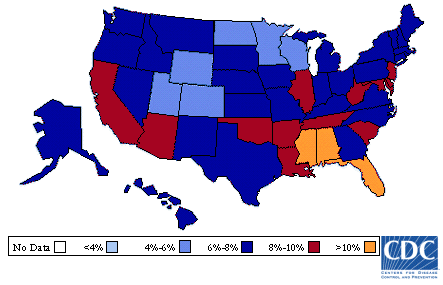
(http://www.cdc.gov/diabetes/statistics/maps/map10.htm)
The above figure shows a survey of the U.S. population with or at high
risk for diabetes in 2002.
[High Risk]
[Type I]
[Type II]
[Gestational]
[Prediabetes]
Diagnostic Tests for Type
I and II
Diagnostic Tests for
Gestational
Back to Diagnosis and Treatment Mainpage

(http://www.cdc.gov/diabetes/statistics/maps/map10.htm)
The above figure shows a survey of the U.S. population with or at high
risk for diabetes in 2002.
According
to the National Institue of Diabetes
and Digestive and Kidney Dieseases (NIDDK), the following criteria
define people at high risk for developing Diabetes:
being more than 20% above ideal body weight or having a body mass index (BMI) above 27 (kg/m2) having an immediate relative with diabetes being African American, Alaska Native, American Indian, Asian American, Hispanic American, or Pacific Islander American having given birth to a baby weighing greater than 9 lbs or having gestational diabetes having a blood pressure of greater than 140/90 mmHg having abnormal blood lipid levels (HDL cholesterol less than 35 mg/dL or triglyercides greater than 250 mg/dL) showing abnormal glucose tolerance in previous diagnostic tests
Type I- This form of diabetes is most often seen in children and accounts for 5-10% of the diagnosed cases of diabetes in the United States. The symptoms can occur years after beta cell destruction has taken place, and include:
increased thirst and urination constant hunger weight loss blurred vision extreme fatigue rapid breathing dry, itchy skin high blood pressure tingling or burning sensation in extremeties of body frequent infections (urinary tract-, yeast-, and skin-infections)
Type I diabetes has been shown
to occur equally in males and females, though it is more common in peoples
of European descent than the rest of the world.
Type II- Almost 95% of diagnosed diabetes in the United States occur in this form, usually affecting the elderly and overweight. The symptoms of Type II diabetes develope much more gradually than in Type I and include:
This form is quite frequently asymptomatic and it is usually found during routine medical examinations or in patients showing late complications of the disease.fatigue or nausea frequent urination unusual thirst weight loss blurred vision frequent infections (urinary tract-, yeast-, and skin-infections) slow healing of wounds or sores high blood pressure
Type II diabetes displays the opposite trend of Type I, in that it is less common in peoples of European and Asian descent than the rest of the population. In some American Indian tribes, diabetes has been found to occur in 1 out of 2 adults.
Due to the increasing occurence of obesity in young children, this type
of diabetes is posing a national health risk. Diabetes can go undetected
in children for long periods of time because children show few and highly
varied symptoms of the disease.
Gestational-
This is the least frequent of the three forms, and develops in about 4%
of females during pregnancy. Like Type II, it is more common in peoples
not of European or Asian descent. It also makes the mother more succeptable
to developing Type II diabetes after pregnancy.
Almost 2 out of 3 women who have
had Gestational diabetes during a pregnancy will develop it during successive
pregnancies as well.
IFG (impaired fasting glucose)- This condition is present at elevated glucose levels, when fasting plasma glucose is between 110 to 125 mg/dL.[Back to Top]IGT (impaired glucose tolerance)- If the blood glucose level during the OGTT is elevated to between 141 and 199 mg/dL 2 hours into the test, a patient is said to have this condition.
page by Jeff Klomp